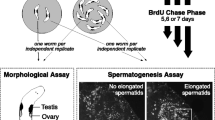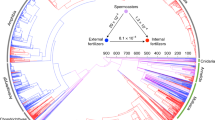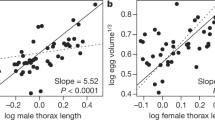Abstract
Evolutionary theory predicts that males should produce more sperm when sperm competition is high. Because sperm production rate is difficult to measure in most organisms, comparative and experimental studies have typically used testis size instead, while assuming a good correspondence between testis size and sperm production rate. Here we evaluate this common assumption using the marine flatworm Macrostomum lignano, in which we can estimate sperm production rate because the accumulation of produced sperm can be observed in vivo. In earlier studies we have shown that testis size is phenotypically plastic in M. lignano: worms can be induced to make larger testes by raising them in groups instead of pairs, and these larger testes have a higher cell proliferation activity (i.e. they are more energetically costly). Here we demonstrate that worms with such experimentally enlarged testes have a higher sperm production rate. Moreover, although testis size and sperm production rate were related linearly, worms with experimentally enlarged testes had a higher sperm production rate per unit testis size (i.e. a higher spermatogenic efficiency). We thus show that phenotypically plastic adjustment of sperm production rate includes a component that is independent of testis size. We discuss possible reasons for this novel finding, and suggest that the relationship between testis size and sperm production needs to be evaluated in other species as well.



Similar content being viewed by others
References
Amann RP (1970) Sperm production rates. In: Johnson AD, Gomes WR, Vandermark NL (eds) The testis. Academic Press, New York, pp 433–482
Andersen RA, Berges JA, Harrison PJ, Watanabe MM (2005) Recipes for freshwater and seawater media. In: Andersen RA (ed) Algal culturing techniques. Elsevier, Amsterdam, pp 429–538
Aspbury AS, Gabor CR (2004a) Differential sperm priming by male sailfin mollies (Poecilia latipinna): effects of female and male size. Ethology 110:193–202
Aspbury AS, Gabor CR (2004b) Discriminating males alter sperm production between species. Proc Natl Acad Sci USA 101:15970–15973
Bozynski CC, Liley NR (2003) The effect of female presence on spermiation, and of male sexual activity on ‘ready’ sperm in the male guppy. Anim Behav 65:53–58
Brauer VS, Schärer L, Michiels NK (in press) Phenotypically flexible sex allocation in a simultaneous hermaphrodite. Evolution
Byrne PG, Roberts JD, Simmons LW (2002) Sperm competition selects for increased testes mass in Australian frogs. J Evol Biol 15:347–355
Cooke PS, Porcelli J, Hess RA (1992) Induction of increased testis growth and sperm production in adult rats by neonatal administration of the goitrogen propylthiouracil (PTU): the critical period. Biol Reprod 46:146–154
Cooke PS, Zhao YD, Hansen LG (1996) Neonatal polychlorinated biphenyl treatment increases adult testis size and sperm production in the rat. Toxicol Appl Pharmacol 136:112–117
de Reviers M, Williams JB (eds) (1984) Testis development and production of spermatozoa in the cockerel (Gallus domesticus). British Poultry Science, Harlow
Evans JP, Magurran AE (1999) Geographic variation in sperm production by Trinidadian guppies. Proc R Soc Lond B 266:2083–2087
Gage MJG (1994) Associations between body size, mating pattern, testis size and sperm lengths across butterflies. Proc R Soc Lond B 258:247–254
Gage MJG, Freckleton RP (2003) Relative testis size and sperm morphometry across mammals: no evidence for an association between sperm competition and sperm length. Proc R Soc Lond B 270:625–632
Gage MJG, Stockley P, Parker GA (1995) Effects of alternative male strategies on characteristics of sperm production in the Atlantic salmon (Salmo salar): theoretical and empirical investigations. Phil Trans R Soc Lond B 350:391–399
Gupta G, Maikhuri JP, Dwivedi AK, Dhar JD, Setty BS (1999) Changes in daily sperm production rate in rats under the influence of a potent antispermatogenic agent, CDRI 84/35. Contraception 59:401–404
Hellriegel B, Blanckenhorn WU (2002) Environmental influences on the gametic investment of yellow dung fly males. Evol Ecol 16:505–522
Hosken DJ (1997) Sperm competition in bats. Proc R Soc Lond B 264:385–392
Johnson RK, Eckardt GR, Rathje TA, Drudik DK (1994) 10 generations of selection for predicted weight of testes in swine – direct response and correlated response in body-weight, backfat, age at puberty, and ovulation rate. J Anim Sci 72:1978–1988
Ladurner P, Rieger RM, Baguña J (2000) Spatial distribution and differentiation potential of stem cells in hatchlings and adults in the marine platyhelminth Macrostomum sp.: a bromodeoxyuridine analysis. Dev Biol 226:231–241
Ladurner P, Schärer L, Salvenmoser W, Rieger RM (2005) A new model organism among the lower Bilateria and the use of digital microscopy in taxonomy of meiobenthic Platyhelminthes: Macrostomum lignano, n. sp (Rhabditophora, Macrostomorpha) J Zool Syst Evol Res 43:114–126
LaMunyon CW, Ward S (1998) Larger sperm outcompete smaller sperm in the nematode Caenorhabditis elegans. Proc R Soc Lond B 265:1997–2002
LaMunyon CW, Ward S (1999) Evolution of sperm size in nematodes: sperm competition favours larger sperm. Proc R Soc Lond B 266:263–267
LaMunyon CW, Ward S (2002) Evolution of larger sperm in response to experimentally increased sperm competition in Caenorhabditis elegans. Proc R Soc Lond B 269:1125–1128
Malo AF, Roldan ER S, Garde J, Soler AJ, Gomendio M (2005) Antlers honestly advertise sperm production and quality. Proc R Soc Lond B 272:149–157
Minder AM, Hosken DJ, Ward PI (2005) Co-evolution of male and female reproductive characters across the Scathophagidae (Diptera). J Evol Biol 18:60–69
Møller AP (1989) Ejaculate quality, testes size and sperm production in mammals. Funct Ecol 3:91–96
Moreira JR, Macdonald DW, Clarke JR (1997) Correlations of testis mass in capybaras (Hydrochaeris hydrochaeris): dominance assurance of sperm competition. J Zool 241:457–463
Morrow EH, Gage MJG (2000) The evolution of sperm length in moths. Proc R Soc Lond B 267:307–313
Nakatsuru K, Kramer DL (1982) Is sperm cheap? Limited male fertility and female choice in the lemon tetra (Pisces, Characidae). Science 216:753–755
Newlon AW, Yund PO, Stewart-Savage J (2003) Phenotypic plasticity of reproductive effort in a colonial ascidian, Botryllus schlosseri. J Exp Zool A 297A:180–188
Parker GA (1998) Sperm competition and the evolution of ejaculates: towards a theory base. In: Birkhead TR, Møller AP (eds) Sperm competition and sexual selection. Academic Press, London, England, pp 3–54
Peirce EJ, Breed WG (2001) A comparative study of sperm production in two species of Australian arid zone rodents (Pseudomys australis, Notomys alexis) with marked differences in testis size. Reproduction 121:239–247
Pilastro A, Scaggiante M, Rasotto MB (2002) Individual adjustment of sperm expenditure accords with sperm competition theory. Proc Natl Acad Sci USA 99:9913–9915
Pitnick S, Markow TA (1994a) Large-male advantages associated with costs of sperm production in Drosophila hydei, a species with giant sperm. Proc Natl Acad Sci USA 91:9277–9281
Pitnick S, Markow TA (1994b) Male gametic strategies: sperm size, testes size, and the allocation of ejaculate among successive mates by the sperm-limited fly Drosophila pachea and its relatives. Am Nat 143:785–819
Pitnick S, Miller GT, Reagan J, Holland B (2001) Males’ evolutionary responses to experimental removal of sexual selection. Proc R Soc Lond B 268:1071–1080
Radwan J (1996) Intraspecific variation in sperm competition success in the bulb mite: a role for sperm size. Proc R Soc Lond B 263:855–859
Rathje TA, Johnson RK, Lunstra DD (1995) Sperm production in boars after 9 generations of selection for increased weight of testis. J Anim Sci 73:2177–2185
Rieger RM, Gehlen M, Haszprunar G, Holmlund M, Legniti A, Salvenmoser W, Tyler S (1988) Laboratory cultures of marine Macrostomida (Turbellaria). Fortschr Zool 36:523
Sall J, Lehman A (1996) JMP start statistics: A guide to statistical and data analysis using JMP, JMPIN software. Duxbury Press, Belmont, USA
Schärer L, Joss G, Sandner P (2004a) Mating behaviour of the marine turbellarian Macrostomum sp.: these worms suck. Mar Biol 145:373–380
Schärer L, Ladurner P (2003) Phenotypically plastic adjustment of sex allocation in a simultaneous hermaphrodite. Proc R Soc Lond B 270:935–941
Schärer L, Ladurner P, Rieger RM (2004b) Bigger testes do work more: experimental evidence that testis size reflects testicular cell proliferation activity in the marine invertebrate, the free-living flatworm Macrostomum sp. Behav Ecol Sociobiol 56:420–425
Schärer L, Sandner P, Michiels NK (2005) Trade-off between male and female allocation in the simultaneously hermaphroditic flatworm Macrostomum sp. J Evol Biol 18:396–404
Schärer L, Zaubzer J, Salvenmoser W, Seifarth C, Ladurner P (in press) Tracking sperm of a donor in a recipient: an immunocytochemical approach. Animal Biol
Tuttle EM, Pruett-Jones S (2004) Estimates of extreme sperm production: morphological and experimental evidence from reproductively promiscuous fairy-wrens (Malurus). Anim Behav 68:541–550
Tuttle EM, Pruett-Jones S, Webster MS (1996) Cloacal protuberances and extreme sperm production in Australian fairy-wrens. Proc R Soc Lond B 263:1359–1364
Tyler S (1981) Development of cilia in embryos of the turbellarian Macrostomum. Hydrobiologia 84:231–239
Wedell N, Gage MJG, Parker GA (2002) Sperm competition, male prudence and sperm-limited females. Trends Ecol Evol 17:313–320
Wistuba J, Schrod A, Greve B, Hodges JK, Aslam H, Weinbauer GF, Luetjens CM (2003) Organization of seminiferous epithelium in primates: relationship to spermatogenic efficiency, phylogeny, and mating system. Biol Reprod 69:582–591
Acknowledgements
We would like to thank Christof Seifarth, Peter Ladurner and Johanna Zaubzer for help and support in the laboratory. Giorgina Bernasconi, Bernhard Egger, Dominique Joly, Peter Ladurner and Klaus Reinhardt provided helpful discussion and comments on the manuscript. During this study L.S. was supported by a Lise-Meitner-fellowship (FWF, Austria), an advanced researcher fellowship (SNF, Switzerland), and a start-up fellowship of the Tyrolean Science Foundation (TWF, Austria).
Author information
Authors and Affiliations
Corresponding author
Rights and permissions
About this article
Cite this article
Schärer, L., Vizoso, D.B. Phenotypic plasticity in sperm production rate: there’s more to it than testis size. Evol Ecol 21, 295–306 (2007). https://doi.org/10.1007/s10682-006-9101-4
Received:
Accepted:
Published:
Issue Date:
DOI: https://doi.org/10.1007/s10682-006-9101-4




